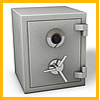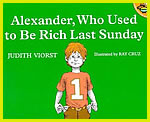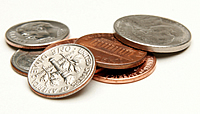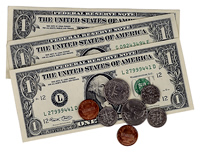Second Grade - Mathematics
Activities
Alexander Who Used to be Rich Last Sunday
Financial and Economic Concepts: Producers and Consumers, Productivity Second Grade
Second Grade
2NBT.5: Fluently add and subtract within 100 using strategies based on place value, properties of operations, and/or the relationship between addition and subtraction

Alexander Who Used to be Rich Last Sunday
by Judith Viorst
ISBN: 1416996214
Lesson Time: 30-40 minutes (Could be continued with the extention activities over a few days.)
Materials: Alexander, Who Used to be Rich Last Sunday, 12” x 18” paper divided into 10 boxes, paper and pencil, coin manipulatives, pencils
Read "Alexander, Who Used to Be Rich Last Sunday" aloud to your students.
Divide the class into pairs, and give each a set of coin manipulatives. Tell them that you are going to read the book again and that they are to remove the number of coins Alexander spends at each point in the story from their manipulatives. When you've finished the book, check to see if any pair still has "unspent" coins.
Provide a work page that is 12” x 18” which contains 10 boxes marked off for the student to record each “transaction” that is made. Read the book again, stopping at each "transaction" so the students can record it on the paper. For example, have students write the amount of money Alexander receives from his grandparents in the first box. Then in the second box, have them calculate how much money Alexander has left after he buys all his gum. Continue this way throughout the story until Alexander has spent his last 20 cents.
![]() Cards (pdf)
Cards (pdf)
Additional Lesson
Allowances & Spending Plans overview
Children begin learning how to manage small amounts of money. They can divide their money into several categories, including "spend," "save," and "give." At the same time, they can spend their money and keep a record of what was spent.
This lesson provides an introduction to allowances for young children. Allowances are the first step to understanding written spending plans or budgets. With guidance in managing allowances in childhood, children can become financially responsible adults. Adults with effective budget skills create healthier family relationships and contribute to building a stronger economy.
Teachers and parents can encourage children to keep track of the money that they spend for their needs and wants. They can work on setting goals together, providing practice in developing effective spending plans, and follow where their money goes.
Lesson Objectives
- Recognize how to divide an allowance into a spending plan.
- Learn how to balance income and expenses.
- Gain confidence in preparing spending plans.
![]() Student Activity Sheets (pdf)
Student Activity Sheets (pdf)
This activity helps students learn that money is a limited resource.
- Give each student a set of expenditure cards and 15 beans (or similar small objects).
- Explain that the beans represent their allowance (income).
- Ask the students to allocate their allowance to the expenditure categories on the cards by placing beans on the squares.
- There are more squares than beans, so students must make choices of where to spend their allowance.
- Each card offers different amounts of spending choices. This helps students consider alternatives within each spending category.
- Discuss the choices they made.
- Optional: After students have allocated their allowance, take away four beans.
- This represents loss of income.
- It forces students to further refine their spending choices.
Big Banks & Piggy Banks
Financial and Economic Concepts: Savings and Financial Investments; Loans, including interest, credit card debt, predatory lending, and payday loans. Second Grade – Mathematics
Second Grade – Mathematics
2.NBT.1: Understand that the three digits of a three-digit number represent amounts of hundreds, tens, and ones
2.NBT.4: Compare two three-digit numbers based on meanings of the hundreds, tens and ones digits
2.NBT.5: Fluently add and subtract within 100 using strategies based on place value and properties of operations, and/or the relationship between addition and subtraction.
2.NBT.6: Add up to four two-digit numbers using strategies based on place value and properties of operations.
2.MD.8: Solve word problems involving dollar bills, quarters, dimes, nickels, and pennies using money symbols appropriately.
When choosing a place to put their money, people consider how safe there money will be, how easy it is to access, and whether it will earn more money. Students explore how well different savings places achieve these objectives. Students learn that people who do not want to carry money with them or keep it at home often choose to put their money in a savings account at a bank or credit union. These financial institutions protect money from theft and other losses. These institutions also pay interest on money deposited.
Deposit - Withdrawal Activity
Financial and Economic Concepts: Banking and Financial Services, including balancing a checkbook or bank account Second Grade – Mathematics
Second Grade – Mathematics
2.MD.8: Solve word problems involving dollar bills, quarters, dimes, nickels, and pennies, using $ and ¢ symbols appropriately. Example: If you have 2 dimes and 3 pennies, how many cents do you have?
2.NBT. 1: Understand that the three digits of a three-digit number represent amounts of hundreds, tens, and ones; e.g., 706 equals 7 hundreds, 0 tens, and 6 ones. Understand the following as special cases:
- 100 can be thought of as a bundle of ten tens — called a “hundred.”
- The numbers 100, 200, 300, 400, 500, 600, 700, 800, 900 refer to one, two, three, four, five, six, seven, eight, or nine hundreds (and 0 tens and 0 ones).
2.NBT. 6: Add up to four two-digit numbers using strategies based on place value and properties of operations.
 Time: 20-25 Minutes
Time: 20-25 Minutes
Materials: Savings account activity (1 for each small group), Savings Account Math Activity Worksheet for each student
Write the words "deposit" and "withdrawal" on the board. Put a plus sign next to the word "deposit" and tell the students that when people put money in a savings account at a bank or credit union they are making a deposit. Next, put a negative sign beside the word "withdrawal" and explain that people make a withdrawal when they take money out of a savings account.
Divide the students into teams or small groups. Provide each group with a copy of the Savings Account Activity.
 Have the students shuffle the cards and stack them face down on a flat surface. To play, students take turns drawing a card from a stack. The student who draws the card must identify the value of the card and note if it is a withdrawal or a deposit. The student then adds or subtracts the amount to or from his or her balance (start the activity by providing each group with a starting balance). The other members of the team should check the player's math. Have the students continue to take turns until they fill the last box on the sheet (or have a zero balance).
Have the students shuffle the cards and stack them face down on a flat surface. To play, students take turns drawing a card from a stack. The student who draws the card must identify the value of the card and note if it is a withdrawal or a deposit. The student then adds or subtracts the amount to or from his or her balance (start the activity by providing each group with a starting balance). The other members of the team should check the player's math. Have the students continue to take turns until they fill the last box on the sheet (or have a zero balance).
![]() Withdraw & Deposit cards (pdf)
Withdraw & Deposit cards (pdf)
![]() Savings Account Math Activity Worksheet (pdf)
Savings Account Math Activity Worksheet (pdf)
Great Graphs
Financial and Economic Concepts: Coin Recognition Second Grade – Mathematics
Second Grade – Mathematics
2.NBT.6: Add up to four two-digit numbers using strategies based on place value and properties of operations.
2.MD.8: Solve word problems involving dollar bills, quarters, dimes, nickels, and pennies, using $ and ¢ symbols appropriately.
2.MD. 10: Draw a picture graph and a bar graph (with single-unit scale) to represent a data set with up to four categories. Solve simple put together, take-apart, and compare problems using information presented in a bar graph.
 Materials: Worksheet
Materials: Worksheet
Time:15-20 Minutes
Students will compare sets of coins and determine which group is greater than, less than, or equal to the other according to the number and value of each set. Students will
read and interpret a simple bar graph to answer questions.
![]() Great Graphs Activities (pdf)
Great Graphs Activities (pdf)
Pennies, Nickels and Dimes ….. Oh, My!
Financial and Economic Concepts: Coin Recognition Second Grade - Mathematics
Second Grade - Mathematics
2.NBT.2: Count within 1000; skip-count by 5s, 10s, and 100s.
2.OA.4: Use addition to find the total number of objects arranged in rectangular arrays with up to 5 rows and up to 5 columns.
 Students will play a game in which they determine the number of cents (pennies) that
equal a nickel, dime, and quarter. The students will also identify which set of coins has
more, fewer, or the same amount while also counting each collection and writing the
corresponding value.
Students will play a game in which they determine the number of cents (pennies) that
equal a nickel, dime, and quarter. The students will also identify which set of coins has
more, fewer, or the same amount while also counting each collection and writing the
corresponding value.
![]() Complete Lesson Plan (pdf)
Complete Lesson Plan (pdf)
Materials:
- The “What’s The Value?” worksheet
- The “How Many Make a…?” worksheet
- Colored pencils and/or crayons
- One of each coin: cent, nickel, dime, and quarter
- Glue
- Scissors
- Value card sets
Preparations:
- Make copies of the “What’s The Value?” worksheet (1 per student)
- Make copies of the “How Many Make a…?” worksheet (1 per student)
- Create value card sets, one per student plus a teacher set using the Value Cards resource page included.
Class Time: 1 30-minute session
Steps:
- To review the value of a cent, nickel, dime and quarter as a class, play the following
game with your students.
- Give each student a set of value cards. Tell them to lay out each card in front of them.
- Hold up one of the four coins for all students to see. Ask students to select a value card and hold it up to show the number of cents that the coin is worth.
- Ask the students how many cents this coin is worth. Solicit group response.
- Show the students the correct value (selected from the teacher’s set of value cards).
- Ask students if that coin’s value is greater than, less than, or equal to a different coin that you select.
- Repeat numerous times, randomly selecting one of the four coins. (As a challenge, display all four coins in a random order. Have the students place the corresponding value cards in that same order.)
- Introduce the “How Many Make a …?” worksheet. Review the directions with the class and ask students to complete this worksheet individually. When students finish, check worksheets for understanding.
- Work with students to complete the “What’s the Value?” worksheet. This can be completed as a class or in small groups with or without supervision as necessary.
Learning About Money
Financial and Economic Concepts: Savings and Financial Investments Second Grade - Mathematics
Second Grade - Mathematics
2.NBT.1: Understand that the three digits of a three-digit number represent amounts of hundreds, tens, and ones.
2.NBT.2: Count within 1000; skip-count by 5s, 10s, and 100s.
 Materials: Real coins (penny, nickel, dime, quarter), Laminated large coins, Chart paper, Containers to make banks (boxes, jars, or bottles), Stickers, markers, etc. for decorating banks, Large 100 chart
Materials: Real coins (penny, nickel, dime, quarter), Laminated large coins, Chart paper, Containers to make banks (boxes, jars, or bottles), Stickers, markers, etc. for decorating banks, Large 100 chart
Time: 45 minutes
This lesson's goal is to teach the children how to identify and count coins, learn about saving and the value of earning money.
Circle Time
Prepare for this lesson by mounting and laminating, both front and back of a real penny, nickel, dime and quarter on cardstock. Pass the display around so the children can examine it up close. Initiate a discussion of the color, characteristics and value of the coins. Talk about how people long ago would trade or barter for supplies and food, instead of using actual money. Open a brainstorming discussion on ways each student could earn money to save for something special. Extend the discussion by asking children what they are saving for, or would like to save for. Make a chart of the students responses. Share the history of the piggy bank, since the students will be making their own bank. Years ago, when metal was very expensive, people made their dishes and pottery from an inexpensive clay, called pygg. They would save their money in jars made of pygg. This is where the "piggy bank" comes from.
Activity
You will need a variety of containers, such as jars, small boxes or water bottles. Encourage the children to be creative by decorating their banks with stickers and markers. Encourage the children to save their money in their banks at home. Discuss possible items they are interested in saving for.
Math
Working with a number chart 1-100, give each child a "nickel". Place the first nickel on the zero. As each child comes up, he or she will count to 5 and tape the nickel on the number 5. The next student counts five and tapes the nickel on the number 10. As each child places a nickel, ask how much money do we have. Continue until they get to 100. This teaches them that a nickel is worth 5 cents. You may also extend the lesson by doing this with a dime or a quarter.
Suggested books to read:
- Bunny Money by Rosemary Wells
- One Cent, Two Cent, Old Cent, New Cent: All About Money by Bonnie Worth and Aristides Ruiz
- The Berenstain Bears' Trouble With Money by Stan and Jan Berenstain
![]() 1-100 Counting Chart (pdf)
1-100 Counting Chart (pdf)


